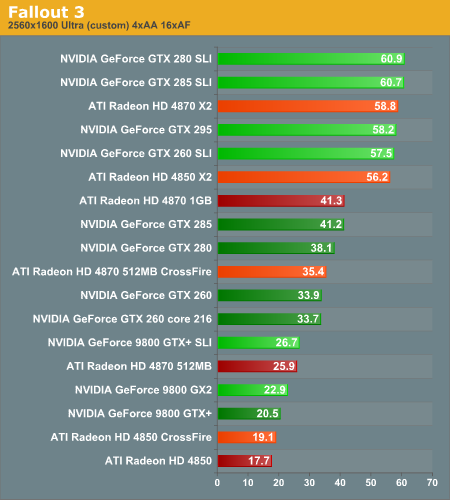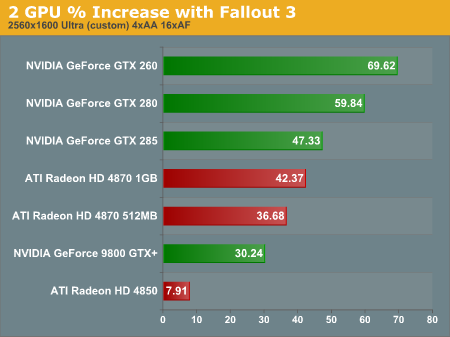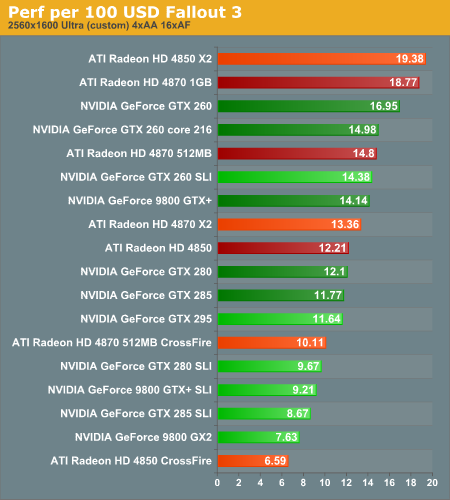MultiGPU Update: Two-GPU Options in Depth
by Derek Wilson on February 23, 2009 7:30 AM EST- Posted in
- GPUs
Fallout 3 Analysis
Try as we might, Fallout 3 performance is very limited by LOD optimizations. We tweaked the .ini files as much as we could to make performance GPU limited, but we just shifted maximum performance down across the board. This is similar to how Oblivion behaved with single card solutions, but this time even multiGPU solutions are affected. It's not a failing of the game, as we do recommend turning on vsync and (if possible) triple buffering when gaming; it just makes testing "goodness" of a graphics card more difficult.

1680x1050 1920x1200 2560x1600
None of our single GPU options hits the frame limit, which does help. Everything runs fine at 1680x1050 and all the multiGPU options are essentially equivalent in performance at this resolution. Moving up to 1920x1200, we see a similar situation, but the 9800 GX2 starts to fall off a bit. Luckily 2560x1600 offers us a better look at what cards stand up when really pushed by Bethesda's modified Gamebryo engine.
Graphics memory becomes a factor at high resolution, and the multiGPU options with only 512MB per card tank in performance. Both 9800 series options and the 4870 512MB / 4850 CrossFire options drop off sharply in performance. This leaves the 4870 X2 and 4850 X2 solutions in competition with the latest and greatest from NVIDIA at the top of the heap. It's clear that the highest end NVIDIA parts have more headroom still, but unfortunately this test won't reveal everything they can do. The 4850 X2 2GB and GTX 260 SLI do drop a little off the frame limit, but the drop isn't hugely consequential.

1680x1050 1920x1200 2560x1600
Scaling data is horrible here because of the limited framerate. Basically, rather than looking at how much better two cards perform, the metric is how slow the single card is. Thus the best scaling we see in this game comes from the 9800 GTX+ and the 4850 until we hit 2560x1600. When we start to finally get a glimpse of real scaling in Fallout 3, the GT200 based NVIDIA cards definitely take the cake.

1680x1050 1920x1200 2560x1600
In terms of value, the frame limit also hurts multiGPU solutions because despite the increased cost, you can only squeeze so much performance out of the hardware. Once again, we note though that the 4850 X2 has very good value and good performance especially compared to the single GTX 280 and 285.










95 Comments
View All Comments
kmmatney - Monday, February 23, 2009 - link
Especially at the 1920 x 1200 resolution - that resolution is becoming a sweetspot nowadays.just4U - Monday, February 23, 2009 - link
I disagree. I see people finally moving away from their older 17-19" flat panels directly into 22" wide screens. 24" and 1920/1200 resolutions are no where near the norm.SiliconDoc - Wednesday, March 18, 2009 - link
Correct, but he said sweet spot because his/her wallet is just getting bulgy enough to comtenplate a movement in that direction... so - even he/she is sadly stuck at "the end user resolution"...lol
Yes, oh well. I'm sure everyone is driving a Mazerati until you open their garage door....or golly that "EVO" just disappeared... must have been stolen.
DerekWilson - Monday, February 23, 2009 - link
The 1GB version should perform very similarly to the two 4850 cards in CrossFire.The short answer is that the 1GB version won't have what it takes for 2560x1600 but it might work out well for lower resolutions.
We don't have a 1GB version, so we can't get more specific than that, though this is enough data to make a purchasing decision -- just look at the 4850 CrossFire option and take into consideration the cheaper price on the 1GB X2.
politbureau - Tuesday, June 1, 2010 - link
I realize this is an older article, however I always find it interesting to read when upgrading cards.While I find it admirable that Derek has compared the 'older' GTX 280 SLI scaling, it is unfortunate that he hasn't pointed out that it should perform identically to the GTX 285s if the clocks were the same.
This was also passed over in the "worthy successor" article, where it does not compare clock for clock numbers - an obvious test, if we want to discover the full value of the die shrink.
I recently 'upgraded' to 3 GTX 285s from 3 GTX 280s through warranty program with the mfg, and there is little to no difference in performance between the 2 setups. While cabling is more convenient (no 6 to 8 pin adapters), the 285s won't clock any better than my 280s would, Vantage scores are within a couple hundred points of each other at the same clocks (the 280s actually leading), and the temperature and fan speed of the new cards hasn't improved.
I think this is a valuable point in an article that compares performance per dollar, and while slightly outside the scope of the article, I think it's a probabtive observation to make.